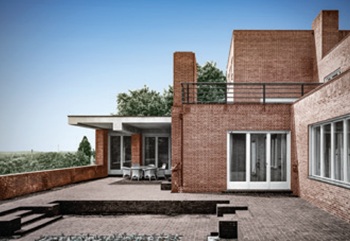Fabric first
A ‘fabric first’ approach to building design involves maximising the performance of the components and materials that make up the building fabric itself, before considering the use of mechanical or electrical building services systems. This can help reduce capital and operational costs, improve energy efficiency and reduce carbon emissions. A fabric first method can also reduce the need for maintenance during the building’s life.
Buildings designed and constructed using the fabric first approach aim to minimise the need for energy consumption through methods such as:
- Maximising air-tightness.
- Using Super-high insulation.
- Optimising solar gain through the provision of openings and shading.
- Optimising natural ventilation.
- Using the thermal mass of the building fabric.
- Using energy from occupants, electronic devices, cookers and so on.
Focussing on the building fabric first, is generally considered to be more sustainable than relying on energy saving technology, or renewable energy generation, which can be expensive, can have a high embodied energy and may or may not be used efficiently by the consumer.
Having energy efficiency integrated into the building envelope can mean occupants are required to do less to operate their building and not have to adjust their habits or learn about new technologies. This can result in less reliance on the end user regarding the buildings energy efficiency.
Fabric first building systems can be constructed off site, resulting in higher quality and so better performance, reduced labour costs and an increased speed of build.
The government’s approach to zero carbon homes and zero carbon non-domestic buildings adopted the fabric first approach. Developers would have been required first to avoid or mitigate regulated emissions by using on-site energy efficiency measures (such as insulation and low energy heating systems) to achieve a minimum Fabric Energy Efficiency Standards, then to adopt on-site zero carbon technologies (such as solar panels) and finally to use off-site measures to deal with any remaining emissions.
Passivhaus, an energy performance standard for dwellings, commercial, industrial and public buildings, also adopts a fabric-first approach to energy efficiency.
[edit] Related articles on Designing Buildings
- Achieving net zero in social housing.
- Active House.
- Allowable solutions.
- Applying Fabric First principles: Complying with UK energy efficiency requirements FB 80.
- Carbon ratings for buildings.
- CIOB holds net zero event with industry experts and UK Government.
- Code for sustainable homes.
- Fabric first investigation into net zero for existing buildings.
- Fabric first will safeguard heat decarbonisation.
- Passivhaus.
- Passive building design.
- Retrofit.
- Thermal bridging and the Future Homes Standard.
- Zero carbon homes.
- Zero carbon non-domestic buildings.
Featured articles and news
Villa Wolf in Gubin, history and reconstruction. Book review.
Construction contract awards down £1bn
Decline over the past two months compared to the same period last year, follows the positive start to the year.
Editor's broadbrush view on forms of electrical heating in context.
The pace of heating change; BSRIA market intelligence
Electric Dreams, Boiler Realities.
New President of ECA announced
Ruth Devine MBE becomes the 112th President of the Electrical Contractors Association.
New CIAT Professional Standards Competency Framework
Supercedes the 2019 Professional Standards Framework from 1 May 2025.
Difficult Sites: Architecture Against the Odds
Free exhibition at the RIBA Architecture Gallery until 31 May.
PPN 021: Payment Spot Checks in Public Sub-Contracts
Published following consultation and influence from ECA.
Designing Buildings reaches 20,000 articles
We take a look back at some of the stranger contributions.
Lessons learned from other industries.
The Buildings of the Malting Industry. Book review.
Conserving places with climate resilience in mind.
Combating burnout.
The 5 elements of seiri, seiton, seiso, seiketsu and shitsuke.
Shading for housing, a design guide
A look back at embedding a new culture of shading.
The Architectural Technology Awards
The AT Awards 2025 are open for entries!
ECA Blueprint for Electrification
The 'mosaic of interconnected challenges' and how to deliver the UK’s Transition to Clean Power.























